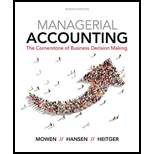
“I know that it’s the thing to do,” insisted Pamela Kincaid, vice president of finance for Colgate Manufacturing. “If we are going to be competitive, we need to build this completely automated plant.”
“I’m not so sure,” replied Bill Thomas, CEO of Colgate. “The savings from labor reductions and increased productivity are only $4 million per year. The price tag for this factory—and it’s a small one—is $45 million. That gives a payback period of more than 11 years. That’s a long time to put the company’s money at risk.”
“Yeah, but you’re overlooking the savings that we’ll get from the increase in quality,” interjected John Simpson, production manager. “With this system, we can decrease our waste and our rework time significantly. Those savings are worth another million dollars per year.”
“Another million will only cut the payback to about 9 years,” retorted Bill. “Ron, you’re the marketing manager—do you have any insights?”
“Well, there are other factors to consider, such as service quality and market share. I think that increasing our product quality and improving our delivery service will make us a lot more competitive. I know for a fact that two of our competitors have decided against automation. That’ll give us a shot at their customers, provided our product is of higher quality and we can deliver it faster. I estimate that it’ll increase our net cash benefits by another $2.4 million.”
“Wow! Now that’s impressive,” Bill exclaimed, nearly convinced. “The payback is now getting down to a reasonable level.”
“I agree,” said Pamela, “but we do need to be sure that it’s a sound investment. I know that estimates for construction of the facility have gone as high as $48 million. I also know that the expected residual value, after the 20 years of service we expect to get, is $5 million. I think I had better see if this project can cover our 14% cost of capital.”
“Now wait a minute, Pamela,” Bill demanded. “You know that I usually insist on a 20%
Required:
- 1. Compute the
NPV of the project by using the original savings and investment figures. Calculate by using discount rates of 14% and 20%. Include salvage value in the computation. - 2. Compute the NPV of the project using the additional benefits noted by the production and marketing managers. Also, use the original cost estimate of $45 million. Again, calculate for both possible discount rates.
- 3. Compute the NPV of the project using all estimates of
cash flows , including the possible initial outlay of $48 million. Calculate by using discount rates of 14% and 20%. - 4. CONCEPTUAL CONNECTION If you were making the decision, what would you do? Explain.
Trending nowThis is a popular solution!

Chapter 12 Solutions
Managerial Accounting: The Cornerstone of Business Decision-Making
- Cariman Company manufactures and sells three styles of door Handles: Gold, Bronze and Silver. Production takes 50, 50, and 20 machine hours to manufacture 1,000-unit batches of Gold, Bronze, and Silver Handles, respectively. The following additional data apply: Projected sales in units Per Unit data: Gold Bronze Silver 60,000 100,000 80,000 2. Determine the activity cost driver rate for setup costs and inspection costs? 3. Using the ABC system, for the Gold style of Handle: a. Calculate the estimated overhead costs per unit? b. Calculate the estimated operating profit per unit? 4. Explain the difference between the profits obtained from the traditional system and the ABC system. Which system provides a better estimate of profitability? Selling price $80 $40 $60 Direct materials $16 $8 $16 Direct labour $30 $6 $18 Overhead cost based on direct labour hours (traditional system) $24 $6 $18 Hours per 1,000-unit batch: Direct labour hours Machine hours Setup hours Inspection hours 80 20 60…arrow_forwardI need some help with problem B. I have done the work, but I'd like to make sure if I have done the calculations correctly. If you see anything else that is wrong, please let me know.arrow_forwardModule 6 Discussion Discuss the significance of recognizing the time value of money in the long-term impact of the capital budgeting decision. 60 Replies, 59 Unread Σarrow_forward
- none.arrow_forwardQuestion 3Footfall Manufacturing Ltd. reports the following financial information at the end of the current year: net sale $100 000 debtor's turnover ration (based on net sales) 2 inventory turnover ration 1.25 fixed assets turnover ratio 0.8 debt to assets ratio 0.6 net profit margin 5% gross profit margin 25% return on investment 2% Use the given information to fill out the templates for income statement and balance sheet given below: Income Statement of Footfall Manufacturing Ltd. for the year ending December 31, 20XX(in $) sales 100,000 cost of goods sold gross profit other expenses earnings before tax tax @50% earnings after tax Balance Sheet of Footfall Manufacturing Ltd. as at December 31, 20XX (in $) liabilities amount assets amount equity net fixed assets long term debt 50, 000 inventory short term debt debtors…arrow_forwardfinal answer.arrow_forward
 Managerial Accounting: The Cornerstone of Busines...AccountingISBN:9781337115773Author:Maryanne M. Mowen, Don R. Hansen, Dan L. HeitgerPublisher:Cengage LearningPrinciples of Accounting Volume 2AccountingISBN:9781947172609Author:OpenStaxPublisher:OpenStax College
Managerial Accounting: The Cornerstone of Busines...AccountingISBN:9781337115773Author:Maryanne M. Mowen, Don R. Hansen, Dan L. HeitgerPublisher:Cengage LearningPrinciples of Accounting Volume 2AccountingISBN:9781947172609Author:OpenStaxPublisher:OpenStax College

